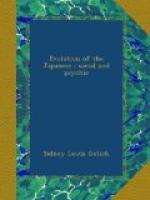Talking not long since to a native friend, concerning the hero-worshiping tendency of the Japanese, I had my attention called to the fact that, while what has been said above is substantially correct as concerns a large proportion of the people, especially the young men, there is nevertheless a class whose ideal heroes are not military, but moral. Their power arises not through self-assertion, but rather through humility; their influence is due entirely to learning coupled with insight into the great moral issues of life. Such has been the character of not a few of the “moral” teachers. I have recently read a Japanese novel based upon the life of one such hero. Omi Seijin, or the “Sage of Omi,” is a name well known among the people of Japan; and his fame rests rather on his character than on his learning. If tradition is correct, his influence on the people of his region was powerful enough to transform the character of the place, producing a paradise on earth whence lust and crime were banished. Whatever the actual facts of his life may have been, this is certainly the representation of his character now held up for honor and imitation. There are also indications that the ideal military hero is not, for all the people, the self-assertive type that I have described above, though this is doubtless the prevalent one. Not long since I heard the following couplet as to the nature of a true hero:
“Makoto no Ei-yu;
Sono yo, aizen to shite shumpu no gotoshi;
Sono shin, kizen to shite kinseki no gotoshi.
“The true Hero;
In appearance, charming like the spring breeze.
In heart, firm as a rock.”
Another phrase that I have run across relating to the ideal man is, “I atte takakarazu,” which means in plain English, “having authority, but not puffed up.” In the presence of these facts, it will not do to think that the ideal hero of all the Japanese is, or even in olden times was, only a military hero full of swagger and bluster; in a military age such would, of necessity, be a popular ideal; but just in proportion as men rose to higher forms of learning, and character, so would their ideals be raised.




